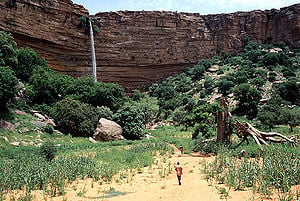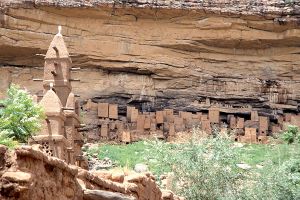Bandiagara Escarpment
| Cliff of Bandiagara (Land of the Dogons)* | |
|---|---|
| UNESCO World Heritage Site | |

| |
| State Party | |
| Type | Mixed |
| Criteria | v, vii |
| Reference | 516 |
| Region** | Africa |
| Inscription history | |
| Inscription | 1989 (13th Session) |
| * Name as inscribed on World Heritage List. ** Region as classified by UNESCO. | |
| Bandiagara Escarpment (Cliffs of Bandiagara) | |
|---|---|
| IUCN Category III (Natural Monument) | |
| | |
| Location: | Mopti Region, Mali |
| Area: | 4,000 km² |
| Established: | 1985 |
The Bandiagara Escarpment is an escarpment in the Dogon country of Mali.
The sandstone cliff rises about 500 meters above the lower sandy flats to the south. It has a length of approximately 150 kilometers. The area of the escarpment is inhabited today by the Dogon people. Before the Dogon the escarpment was inhabited by the Tellem and Toloy. Many structures remain from the Tellem.
The Bandiagara Escarpment was listed in the UNESCO World Heritage List in 1989.
The Cliffs of Bandiagara are a sandstone chain ranging from south to northeast over 200 km and extending to the Grandamia massif. The end of the massif is marked by the Hombori Tondo, Mali's highest peak at 1,115 meters. Because of its archaeological, ethnological and geological characteristics, the entire site is one of the most imposing in West Africa.
The cave-dwelling Tellem, an ethnic group later pushed out by the arrival of the Dogons, used to live in the slopes of the cliff. The Tellem legacy is evident in the caves they carved into the cliffs so that they could bury their dead high up far from the frequent flash floods of the area. Dozens of villages are located along the cliff, such as Kani Bonzon. It was near to this village that the Dogons arrived in the 14th century and from there they spread over the plateau, the escarpment and the plains of the Seno-Gondo.
There is an interesting theory explaining why the Dogon were relatively undisturbed by the french colonial powers. Supposedly there are a series of natural tunnels weaving through the Bandiagara Escarpment which only the Dogon know about and they are able to use these caves to surprise and drive away any aggressors.
Today, local guides can take tourist groups on trips along the Escarpment to visit the Dogon villages. A series of trails run along the cliffs, and hostels in each village provide food and lodging. The host villages receive income from the hostels and the tourist tax.
External links
Credits
New World Encyclopedia writers and editors rewrote and completed the Wikipedia article in accordance with New World Encyclopedia standards. This article abides by terms of the Creative Commons CC-by-sa 3.0 License (CC-by-sa), which may be used and disseminated with proper attribution. Credit is due under the terms of this license that can reference both the New World Encyclopedia contributors and the selfless volunteer contributors of the Wikimedia Foundation. To cite this article click here for a list of acceptable citing formats.The history of earlier contributions by wikipedians is accessible to researchers here:
The history of this article since it was imported to New World Encyclopedia:
Note: Some restrictions may apply to use of individual images which are separately licensed.
